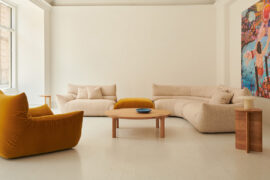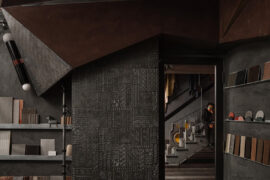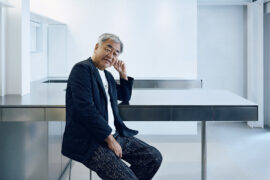In an exclusive interview with one of the most iconic figures on the international design scene, Cappellini’s charismatic art director talks about design that transcends time and geographical context, embraces diversity – and captures the elusive essence of our times.

May 28th, 2024
For over seven decades, Cappellini has been a leading name in contemporary design. Founded as a family-run furniture business in 1946, the brand has undergone a remarkable transformation under Giulio Cappellini’s artistic direction. His insatiable curiosity, keen eye for talent, affinity for immersive storytelling and commitment to innovation have propelled Cappellini to international acclaim.
Here, Cappellini himself talks about the brand’s rich heritage, his focus on cultural context and unwavering affinity for craftsmanship, and the harmonious intersection between the past and the future, masterfully encapsulated in Cappelini’s alluring new collection exhibited at Salone del Mobile.

Tell us about the history of Cappellini and your role in the business.
The company was founded by my father, Enrico, in 1946. Back then, Cappellini was a small family factory producing classic furniture, mainly for northern Italy. I joined in the early 80s, after graduating from the Politecnico di Milano with a degree in architecture and working with Gio Ponti.
I started collaborating with young, unknown designers from various parts of the world, many of whom have now become widely celebrated industry names, such as Jasper Morrison, Marc Newson, the Bourroulec brothers, and Nendo. This focus on elevating new global talent helped transform Cappellini into the innovative international design brand it is today.
In the 2000s, we fused Lifestyle Design with a few other prestigious Italian brands, and, now, I am the company’s art director.

Can you elaborate on the new collection for Salone del Mobile? Who are the designers, and what are the products?
This year, we’re showcasing new products and designers, as well as reintroducing existing pieces from our long-standing collaborators. By bringing together the past and the present, we honour our brand heritage and celebrate tradition, while offering a comprehensive contemporary selection.
New introductions include living room tables by Hsiang Han Hsu from Taiwan and Daisuke Kitagawa from Japan, an expanded collection of Nendo’s Pinch tables, and upholstered pieces like the Ludo Sofa by Patricia Urquiola and the Millepiedi bookcase by Dimore Studio. We’ve also reintroduced iconic designs like the Barber & Osgerby Bottle table and the Piero Lissoni Classica chair. Additionally, there are two limited editions: a unique turquoise Orgone table by Marc Newson and the Out of Scale storage unit by Elena Salmistraro.

What is Capellini’s relationship with local cultures and the past — is it a reinterpretation, an homage?
Our relationship with diverse cultures and geographical locations are of huge importance to us – Cappellini designs products for a global audience, while celebrating the local context. That’s why, while the core design of our pieces tends to remain consistent, individual products may vary in colours, fabrics, finishes, and presentation depending on where they’re manufactured.
In terms of how we relate to the past, our goal isn’t to merely revisit it from a place of nostalgia – it is to share our own story and design heritage through timeless, enduring products.
How do these collections connect with different parts of the world?
Our collections are crafted by a multifaceted cohort of designers from all around the world, emphasising contemporary design and future-oriented concepts. In today’s interconnected world, communication is instantaneous, and events unfold simultaneously worldwide, but safeguarding local identities remains absolutely crucial. An essential part of my role as an art director is to identify the unifying thread that binds these diverse projects.

Can you explain the term “a distillation of modernity”?
“Distillation of modernity” signifies capturing the essence of our times through our products, brand image, and communication. In practice, that entails incorporating contemporary materials, technologies, and production systems in our designs, along with modern colour schemes and textures. At the same time, “a distillation of modernity” means understanding – and reflecting upon – all of the significant socio-cultural phenomena that shape our daily lives.
How important is sustainability for Cappellini today?
In today’s world, it’s imperative that designs and products are created with sustainability in mind – and that goes beyond just using recycled materials in production. For us, it’s a holistic process that prioritises the well-being of our work environment and employee health. There is a growing focus on this issue, particularly amongst the younger generations.

How do you ensure that traditions of craftsmanship are valued and maintained?
We champion the value of craftsmanship as an essential pillar of our industry. Handicrafts embody the art of knowledge and are fundamental elements that must be recognised, protected and celebrated. These traditions encapsulate the history and culture of different countries, passed down through generations. It’s a valuable asset we must preserve.
Cappellini’s thoughtful approach to design, his appreciation of local nuance and global context, as well as unwavering commitment to craftsmanship ensure that the brand continues to be one of the most consequential voices in contemporary design. Anchored by the patient appreciation of the past traditions, yet elevated by gentle optimism for a more sustainable future, Giulio Cappellini’s leadership exemplifies transformative potential of design – a positive force that transcends borders, fosters cultural exchange, and elevates everyday experiences.
With the 2024 Salone collection, Cappellini extends a generous and mindfully curated invitation to celebrate beautiful, multifaceted objects that fuse storytelling and function, bridge past and future – and connect the local context with a global audience.
INDESIGN is on instagram
Follow @indesignlive
A searchable and comprehensive guide for specifying leading products and their suppliers
Keep up to date with the latest and greatest from our industry BFF's!

A curated exhibition in Frederiksstaden captures the spirit of Australian design

Rising above the new Sydney Metro Gadigal Station on Pitt Street, Investa’s Parkline Place is redefining the office property aesthetic.

Neill Johanson, Principal at Davenport Campbell, comments on what we might be losing and gaining with the expansion of remote work.

David Gole, principal at leading climate-resilient design practice JDA Co., comments on the intersection between heritage and climate in architecture.
The internet never sleeps! Here's the stuff you might have missed

Bangalore studio Multitude of Sins elevates true leftovers — not surplus — into a richly layered workspace where waste materials become narrative, structure and sculptural expression.

In a wide-ranging interview, the iconic Japanese architect joins Timothy Alouani-Roby to discuss his childhood home, the influence of Metabolism, a formative experience in the Sahara desert and a recent house by Mount Fuji.